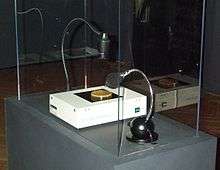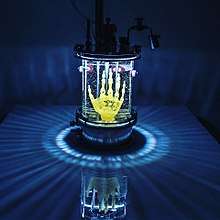BioArt
BioArt is an art practice where humans work with live tissues, bacteria, living organisms, and life processes. Using scientific processes such as biotechnology (including technologies such as genetic engineering, tissue culture, and cloning) the artworks are produced in laboratories, galleries, or artists' studios. The scope of BioArt is considered by some artists to be strictly limited to "living forms", while other artists would include art that uses the imagery of contemporary medicine and biological research, or require that it address a controversy or blind spot posed by the very character of the life sciences.[1]


Although BioArtists work with living matter, there is some debate as to the stages at which matter can be considered to be alive or living. Creating living beings and practicing in the life sciences brings about ethical, social, and aesthetic inquiry. The phrase "BioArt" was coined by Eduardo Kac in 1997 in relation to his artwork Time Capsule. Although it originated at the end of the 20th century, through the works of pioneers like Suzanne Anker, Joe Davis, and the artists hosted by Symbiotica, BioArt is more widely practiced now.
Overview
.tif.jpg)
BioArt is often intended to be shocking or humorous. One survey of the field, Isotope: A Journal of Literary Science and Nature Writing, puts it this way: "BioArt is often ludicrous. It can be lumpy, gross, unsanitary, sometimes invisible, and tricky to keep still on the auction block. But at the same time, it does something very traditional that art is supposed to do: draw attention to the beautiful and grotesque details of nature that we might otherwise never see."[2]
While raising questions about the role of science in society, "most of these works tend toward social reflection, conveying political and societal criticism through the combination of artistic and scientific processes."[3]
While most people who practice BioArt are categorized as artists in this new media, they can also be seen as scientists, since the actual medium within a work pertains to molecular structures, and so forth. Because of this dual-acceptance, the Department of Cell Biology at Harvard University invites anyone to submit works based on scientific or artistic value.[4] This can encourage anyone to submit work they strongly respond to.
Exposing artists to laboratories
The laboratory work can pose a challenge to the artist, at first, as the environment is often foreign to the artist. While some artists have prior scientific training, others must be trained to perform the procedures or work in tandem with scientists who can perform the tasks that are required. Bio artists often use formations relating to or engaged with science and scientific practices, such as working with bacteria or live-tissue.
Much of the art involves tissue-culturing and transgenics, a term for a variety of genetic engineering processes through which genetic material from one organism is altered by the addition of synthesized or transplanted genetic material from another organism.[5]
In 2000, Eduardo Kac commissioned the creation of a transgenic GFP bunny as part of a piece called GFP Bunny. "The PR campaign included a picture of Kac holding a white rabbit and another, iconic image of a rabbit photographically enhanced to appear green."[6]
The Tissue Culture & Art Project in collaboration with Stelarc grew a 1/4 scale replica of an ear using human cells. The project was carried out at Symbiotica: the Art & Science Collaborative Research Laboratory, School of Anatomy and Human Biology, University of Western Australia.[7]
In 2011 the BFA Fine Arts Department of the School of Visual Arts in New York City opened the first Bio Art Laboratory in an art school in the US. The SVA Bio Art Lab offers art students access to scientific tools and techniques to create works of art.
Art addressing topics in biology and society

The scope of the term BioArt is a subject of ongoing debate. The primary point of debate centers around whether BioArt must necessarily involve manipulation of biological material, as is the case in microbial art which by definition is made of microbes. A broader definition of the term would include work that addresses the social and ethical considerations of the biological sciences.[8] Under these terms BioArt as a genre has many crossovers with fields such as critical or speculative design.[9] This type of work often reaches a much broader general audience, and is focused on starting discussions in this space, rather than pioneering or even using specific biological practices. Examples in this space include Ray Fish shoes, which advertised shoes made and patterned with genetically engineered stingray skin,[10] BiteLabs, a biotech startup that attempted to make salami out of meat cultured from celebrity tissue samples,[11] and Ken Rinaldo's Augmented Fish Reality, an installation of five rolling robotic fish-bowl sculptures controlled by Siamese Fighting Fish.[12]
Controversy
BioArt has been scrutinized for its apparent lack of ethics. USA Today reported that animal rights groups accused Kac and others of using animals unfairly for their own personal gain, and conservative groups question the use of transgenic technologies and tissue-culturing from a moral standpoint.[3]
Alka Chandna, a senior researcher with PETA in Norfolk, Virginia, has stated that using animals for the sake of art is no different from using animal fur for clothing material. "Transgenic manipulation of animals is just a continuum of using animals for human end, regardless of whether it is done to make some sort of sociopolitical critique. The suffering and exacerbation of stress on the animals is very problematic."[3]
However, many BioArt projects deal with the manipulation of cells and not whole organisms, such as Victimless Leather by Symbiotica. "An actualized possibility of wearing 'leather' without killing an animal is offered as a starting point for cultural discussion. Our intention is not to provide yet another consumer product, but rather to raise questions about our exploitation of other living beings."[13]
See also
References
- Pentecost, Claire (2008). "Outfitting the Laboratory of the Symbolic: Toward a Critical Inventory of Bioart". In Beatrice, da Costa (ed.). Tactical Biopolitics: Art, Activism and Technoscience. The MIT Press. p. 110. ISBN 978-0-262-04249-9.
- The Art is Alive
- Pasko, Jessica M. (2007-03-05). "Bio-artists use science to create art". USA Today.
- BIOart Archived October 20, 2008, at the Wayback Machine
- "Bio-artists bridge gap between arts, sciences". NBC News. 4 March 2007.
- Pentecost, Claire (2008). "Outfitting the Laboratory of the Symbolic: Toward a Critical Inventory of Bioart". In Beatrice, da Costa (ed.). Tactical Biopolitics: Art, Activism and Technoscience. The MIT Press. p. 107. ISBN 978-0-262-04249-9.
- "Extra Ear ¼ Scale - The Tissue Culture & Art Project in Collaboration with Stelarc".
- See Bio Art entry in Oxford Art Online, Oxford University Press, 2007-2014. (subscription required)
- Anker, Suzanne (2014). "The beginnings and the ends of Bio Art" (PDF). Artlink. 34 (3).
- "The Rise and Fall or Rayfish Footwear - Next Nature Network". 19 December 2012.
- "The Guy Who Wants to Sell Lab-Grown Salami Made of Kanye West Is "100% Serious"". 2014-02-26.
- Prixars Electronica : 2004 CyberArts : international compendium Prix Ars Electronica : computer animation/visual effects, digital musics, interactive art, net vision, digital communities, u19, freestyle computing, the nest idea. Austria: Hatje Cantz. 2004. ISBN 9783775714938.
- "Victemless Leather".
Bibliography
- Sammartano, Paola. Electrophotographs and Photographs with Human Hair for Future Cloning. Sergio Valle Duarte Zoom Internacional, 1995.
- Anker, Suzanne, and Dorothy Nelkin. The Molecular Gaze: Art in the Genetic Age. Cold Spring Harbor, N.Y.: Cold Spring Harbor Laboratory Press, 2004.
- Da Costa, Beatriz, and Kavita Philip (eds.). Tactical Biopolitics: Art, Activism, and Technoscience. Cambridge: MIT Press, 2008.
- Gatti, Gianna Maria. The Technological Herbarium. Edited, translated from the Italian, and with a preface by Alan N. Shapiro. Berlin: Avinus Press, 2010. Online at alan-shapiro.com
- Gessert, George. Green Light: Toward an Art of Evolution. Cambridge: MIT Press/Leonardo Books, 2010. ISBN 978-0-262-01414-4.
- Hauser, Jens. "Bio Art - Taxonomy of an Etymological Monster." UCLA Art/Sci Center series, 2006. Online at
- Hauser, Jens (ed.). sk-interfaces. Exploding borders - creating membranes in art, technology and society. Liverpool: University of Liverpool Press, 2008. ISBN 978-1-84631-149-9.
- Kac, Eduardo.Telepresence and Bio Art. Ann Arbor: University of Michigan Press, 2005. ISBN 978-0-472-06810-4.
- Kac, Eduardo (ed.). Signs of Life: Bio Art and Beyond. Cambridge: MIT Press/Leonardo Books, 2007. ISBN 0-262-11293-0.
- Nicole C. Karafyllis (ed.). Biofakte - Versuch über den Menschen zwischen Artefakt und Lebewesen. Paderborn: Mentis 2003. In German.
- Levy, Steven. "Best of Technology Writing 2007." Ann Arbor: University of Michigan Press, 2007 (in conjunction with DIGITALCULTUREBOOKS)
- Miah, Andy. (ed.). Human Futures: Art in an Age of Uncertainty. Liverpool: Liverpool University Press, 2008. ISBN 978-1-84631-181-9.
- Mitchell, Rob. Bioart and the Vitality of Media. Seattle: University of Washington Press, 2010. ISBN 978-0-295-99008-8.
- Mitchell, Rob, Helen Burgess, and Phillip Thurtle. Biofutures: Owning Body Parts and Information. Pennsylvania: University of Pennsylvania Press, 2008. Interactive DVD.
- Reichle, Ingeborg. Kunst aus dem Labor. Springer, 2005. In German.
- Simou Panagiota, Tiligadis Konstantinos, Alexiou Athanasios. Exploring Artificial Intelligence Utilizing BioArt, 9th Artificial Intelligence Applications and Innovations Conference, IFIP AICT 412, pp. 687–692, 2013, © IFIP International Federation for Information Processing 2013, Springer.
- Thacker, Eugene. "Aesthetic Biology, Biological Art." Contextin' Art (Fall Issue, 2003). Online at
- Thacker, Eugene. The Global Genome - Biotechnology, Politics, and Culture (Massachusetts: MIT Press/Leonardo Books, 2006. pp. 305–320. ISBN 978-0-262-70116-7.
- Vita-More, Natasha. "Brave BioArt 2: Shedding the Bio, Amassing the Nano, and Cultivating Emortal Life." "Reviewing the Future" Summit, Montreal, Canada, Coeur des Sciences, University of Quebec, 2007.
- Wilson, Stephen. "Art and Science Now: How scientific research and technological innovation are becoming key to 21st-century aesthetics." London, England: Thames and Hudson, 2012. ISBN 978-0-500-23868-4
- Zylinska, Johanna. Bioethics in the Age of New Media. Cambridge: MIT Press/Leonardo Books, 2009. ISBN 978-0-262-24056-7.
| Wikimedia Commons has media related to BioArt. |